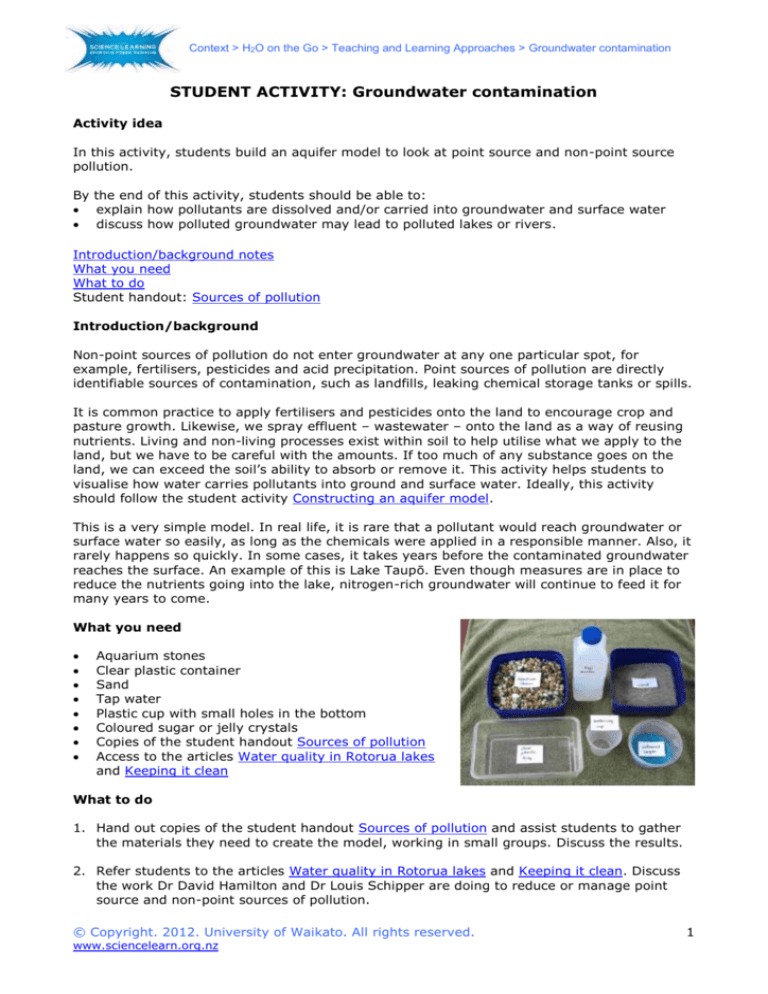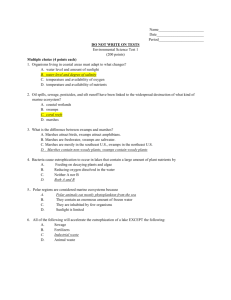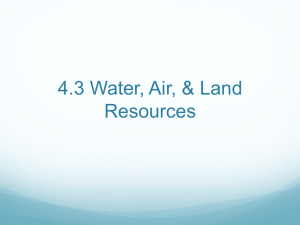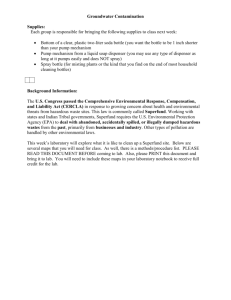
Context > H2O on the Go > Teaching and Learning Approaches > Groundwater contamination
STUDENT ACTIVITY: Groundwater contamination
Activity idea
In this activity, students build an aquifer model to look at point source and non-point source
pollution.
By the end of this activity, students should be able to:
explain how pollutants are dissolved and/or carried into groundwater and surface water
discuss how polluted groundwater may lead to polluted lakes or rivers.
Introduction/background notes
What you need
What to do
Student handout: Sources of pollution
Introduction/background
Non-point sources of pollution do not enter groundwater at any one particular spot, for
example, fertilisers, pesticides and acid precipitation. Point sources of pollution are directly
identifiable sources of contamination, such as landfills, leaking chemical storage tanks or spills.
It is common practice to apply fertilisers and pesticides onto the land to encourage crop and
pasture growth. Likewise, we spray effluent – wastewater – onto the land as a way of reusing
nutrients. Living and non-living processes exist within soil to help utilise what we apply to the
land, but we have to be careful with the amounts. If too much of any substance goes on the
land, we can exceed the soil’s ability to absorb or remove it. This activity helps students to
visualise how water carries pollutants into ground and surface water. Ideally, this activity
should follow the student activity Constructing an aquifer model.
This is a very simple model. In real life, it is rare that a pollutant would reach groundwater or
surface water so easily, as long as the chemicals were applied in a responsible manner. Also, it
rarely happens so quickly. In some cases, it takes years before the contaminated groundwater
reaches the surface. An example of this is Lake Taupō. Even though measures are in place to
reduce the nutrients going into the lake, nitrogen-rich groundwater will continue to feed it for
many years to come.
What you need
Aquarium stones
Clear plastic container
Sand
Tap water
Plastic cup with small holes in the bottom
Coloured sugar or jelly crystals
Copies of the student handout Sources of pollution
Access to the articles Water quality in Rotorua lakes
and Keeping it clean
What to do
1. Hand out copies of the student handout Sources of pollution and assist students to gather
the materials they need to create the model, working in small groups. Discuss the results.
2. Refer students to the articles Water quality in Rotorua lakes and Keeping it clean. Discuss
the work Dr David Hamilton and Dr Louis Schipper are doing to reduce or manage point
source and non-point sources of pollution.
© Copyright. 2012. University of Waikato. All rights reserved.
www.sciencelearn.org.nz
1
Context > H2O on the Go > Teaching and Learning Approaches > Groundwater contamination
Student handout: Sources of pollution
Non-point sources of pollution do not enter groundwater at any one particular spot, for
example, fertilisers, pesticides and acid precipitation. Point sources of pollution are directly
identifiable sources of contamination, such as landfills, leaking chemical storage tanks or spills.
Non-point source pollution
1. Put the aquarium stones in the plastic container. Slope the
stones to form a lake at one end of the model.
2. Add a layer of sand over the stones. (Sand is used instead of
soil to maintain water clarity.) Pat down the sand to minimise
erosion.
3. Sprinkle a few spoonfuls of coloured sugar or jelly crystals
onto the sand to represent the substance being applied to the
land, for example, lawn fertiliser.
4. Hold the cup over the model. Pour some water into the cup to
simulate rain. Move the cup around so it rains over the entire
model. Refill the cup as needed and continue to rain on the
model until a small lake forms.
5. Look at what happens as the rain comes in contact with the
coloured sugar. It dissolves the substance and takes it down
through the soil into the aquifer. If the rain is heavy enough,
some of the sugar runs off into the surface water. Either way,
the contaminant ends up in the ground and surface water.
Point sources of pollution
6. Set up the aquifer model using stones and sand. The sand
layer at the top of the model needs to be fairly thick.
7. Make a small hole and add some coloured sugar. Cover the
sugar with sand to represent an old landfill.
8. Hold the cup over the model. Pour some water into the cup to
simulate rain. Move the cup around so that it rains over the
entire model. Refill the cup as needed and continue to rain on
the model until a small lake forms.
9. Nothing may appear to happen at first. It takes time for the
water to dissolve the contaminants in the landfill, but
eventually the aquifer and the lake will turn the colour of the
sugar. New landfill sites are built to reduce groundwater
pollution. Their design includes a confining layer to prevent
polluted water from escaping. The water is often collected
and pumped to a wastewater treatment plant.
All images © Copyright. 2012. University of Waikato. All rights
reserved.
© Copyright. 2012. University of Waikato. All rights reserved.
www.sciencelearn.org.nz
2










